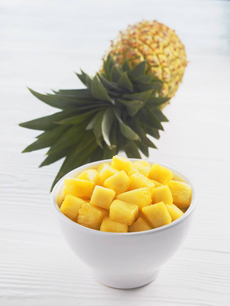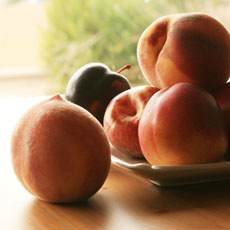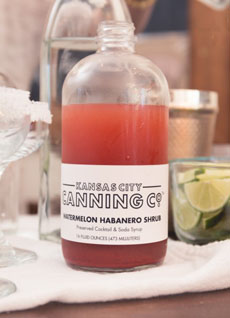TIP OF THE DAY: Make A Shrub, a.k.a. Drinking Vinegar
|
There are shrubs for landscaping, and shrubs for drinking. The latter is an acidulated beverage: made with an acid such as vinegar, lemon or lime juice along with fruit juice, sugar and optional ingredients including herbs, spices and alcohol.
The word is a transposition from the Arabic shurb, a cool drink. In the U.K. today, shrubs are popular fruity vinegar tonics. But they have not yet achieved a level of awareness in the U.S., even when called “drinking vinegar,” a modern term for the syrup that can be used to make cocktails and cocktails. Perhaps ten years ago, we were in the Japanese pavilion at a restaurant industry trade show and first encountered “drinking vinegar.” It was an exquisite shot for an after dinner drink: sweet and tart, complex, exciting. We treasured the bottles we picked up at the show, bringing them to dinners with connoisseur friends, where they were greatly appreciated. Then they were gone, and we moved on. We couldn’t find it for sale, and didn’t realize how easy it was to make it at home. But drinking vinegar moved on too, as vinegar-based shrub drinks began to be revived around 2011—on a limited basis at trendy bars and restaurants in the U.S., Canada and London. The acidity of a shrub makes it a fine digestif* or used as an alternative to bitters in cocktails. There two different types of shrubs, both acidulated mixed drinks: Shrubs date to the 17th century (see the history of shrubs below). Fresh fruits were steeped in vinegar and sugar, and infused anywhere from overnight up to several days. The fruit solids were then strained out to create a sweet-and-tart concentrate that was mixed with spirits, water or sparkling water. Beyond mixology, today’s cooks also add “drinking vinegar” to sauces and salad dressings. We’ve drizzled them on lemon sorbet and rice pudding. You can buy artisan shrub syrups at specialty foods stores, but they tend to be pricey, like any top-quality drink mixer. You can find bottled shrub syrup in flavors like Apple, Ginger and Strawberry as well as compound flavors such as Apple Caraway, Blood Orange Cardamom, Blood Orange Ginger, Meyer Lemon Lavender, Smoked Spiced Pear, Watermelon Habanero (these compound flavors from Kansas City Canning Co.). But it costs very little to make your own. Some people use the ratio of one part fruit, one part sugar and one part vinegar for shrub syrup; but these proportions should vary according to the sweetness of the fruit. If the fruit is particularly sweet, you could cut back on the sugar and increase the fruit ratio. Think seasonally: berries and stone fruits in the summer; apples, pears and quince in the fall; blood oranges and grapefruits in the winter; strawberries, blackberries and pineapple in the spring. While apple cider vinegar is traditional, go beyond it to champagne vinegar, sherry vinegar and flavored vinegar (see the different types of vinegar and how to pair vinegars and foods). Use the instructions below. For an apple shrub, we cut back on the sugar. RECIPE: APPLE CIDER SHRUB Prep time is 5 minutes plus 3-5 days infusing time. Ingredients For 3/4 Quart |
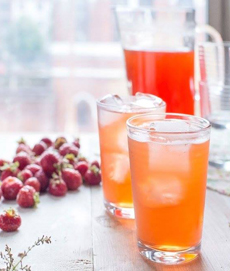
[1] A strawberry shrub (photo courtesy Quinciple). [2] We’re particularly fond of pineapple shrub (photo courtesy Del Monte). [3] In the summer, use stone fruits for your shrubs (photo courtesy Frog Hollow Farms). [4] Beyond apple cider vinegar, consider vinegars flavored with fruit, herbs and spices like these from Boyajian. [5] A bottle of watermelon-habanero shrub from Kansas City Canning Co. (photo © Laura Noll Photography). |
|
|
1. DICE the apples into very small pieces and place in a quart-size mason jar. Add the vinegar and sugar, and the herb sprigs. If there’s room at the top of the jar, add a few more splashes of vinegar. 2. CAP the jar tightly and shake it a few times to blend in the sugar. Place the jar in the fridge for 3-5 days, shaking once or twice. 3. TASTE the shrub after three days. If you like the intensity of flavor, strain out the fruit, first pressing the fruit with the back of the spoon to get all of the juice. Then, store the shrub in an airtight container. Otherwise, let it infuse for two more days. 4. SERVE: Pour the shrub over ice and mix with sparkling water or make a cocktail. Or try it as a shot: We did, and really liked it. †Carbonated water was first created in 1767 by British chemist Joseph Priestley, but was not manufactured commercially until J. J. Schweppe did so in 1783. |
||
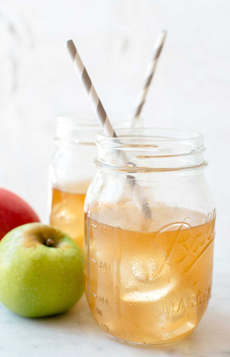 An apple shrub (photo courtesy Good Eggs). The recipe is above. Good Eggs also sells artisan shrubs in blackberry, lemon, lime, strawberry and quince. They’re pricey; hence the option to make your own. |
The shrub is infused (pun intended) with history.
Originally, shrubs were developed as another way to preserve seasonal fruits for consumption throughout the year. The English shrub evolved from the medicinal cordials of the 15th century. As a mixture of fruit and alcohol, the shrub is related to the punch; however, punch is typically served immediately after mixing, while shrub syrup was stored as a mixer for later use. Shrub drinks were sold in English public houses in the 17th and 18th centuries; for the holiday season, shrub was mixed with raisins, honey, lemon, sherry and rum. The syrup was a common ingredient in punch. However, the drink fell out of fashion by the late 1800s. The Colonial American shrub derived from the English version. The vinegar was used as an alternative to citrus juices in the preservation of fruits. Shrubs remained popular for a longer period of time in the U.S.: through the 19th century. According to Wikipedia, shrubs fell out of popularity with the advent of home refrigeration (ice boxes), which enabled a wealth of other cold drinks. Vinegar-based shrub drinks appeared again in 2011-2012. Help to continue the trend: Make some shrub syrup(s) and invite friends over for shrubs. |
|
|
|
||
